[Galactic Journey is not the only San Diego organization that specializes in time travel. Read on and learn about a most extraordinary endeavour happening downtown…]

by Victoria Lucas
As I had hoped in my last message, I made it to San Francisco and now live and here at the end of the "J" streetcar line, at Church and 30th. At first the streetcar woke me up every morning sometime before 6 am, when it makes the "J" figure to turn around at the top on 30th and then squeals down Church to begin its run downtown, where I work. Eventually I got used to it. The only things that wake me up now are the fights the managing couple stages many nights in which she tends to yell out a window into the inner courtyard at 3 am when they are both drunk, and he mutters in the background.
I didn't drive directly here–I really had to stop in San Diego to see a friend of mine in the Shakespeare play I've messed with in my title. I had never been to the San Diego Old Globe Theatre in Balboa Park (one of a number of "Globe Theatres" around the world). More important, I wanted to be sure to see my friend Alan Fudge one last time. Oh, and Alan got me a complimentary ticket (known in the biz as a "comp"). All I had to do was get there, park, and not get lost.
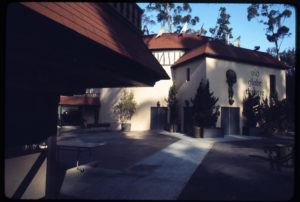
I was first exposed to Shakespeare in high school, and was interested in his language and how he had invented many of the words we take for granted today. We studied his tragedies: I never will understand why teenagers, who have such strong emotions and who often dramatize their lives in tragic terms, as if tempted to try to fit into universal clichés, are made to study tragedy and trauma in literature, instead of biography, humor, politics, and satire.
Nevertheless, I am always fascinated to watch the plays, set as they are in strange surroundings–not on other planets, because it wouldn't have occurred to authors in the 16th and 17th centuries to use such settings–but in other countries so far away and so foreign that the typical person in Shakespeare's audience would have been as likely to journey to the moon as to Denmark (the scene of "Hamlet") or Italy (where the play I saw, "Much Ado About Nothing," is set). Like science fiction, Shakespeare's plays were always located in barely imaginable places, with happenings both close to and removed from the everyday lives of audience members, sometimes for political reasons.

Although "Much Ado About Nothing" depicts rather ordinary humans with ordinary passions, some of Shakespeare's fantasies, such as "Midsummer Night's Dream," imagined very implausible creatures, such as these from an earlier production at the Old Globe.
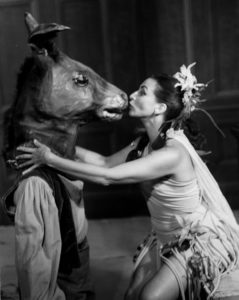
The San Diego Old Globe was built to evoke Elizabethan times just by its architecture. Because it is modeled after the original London theater, entering the building is like climbing out of a time machine. It is hard not to hesitate at the door as if unsure how to behave in the year 1609, when this play, for instance, was first performed.

As in Shakespeare's time, the area below the stage is open to the weather, this part of the theater (now with benches) being called "The Pit", where I could almost see an unruly crowd heckling the players. But the time-machine like quality even extends to the festival performances outside, where people from another era are likely to erupt from buildings or from behind trees.
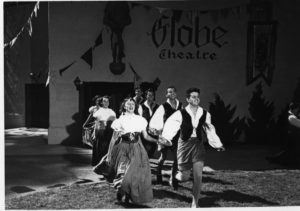
So it is a shock to recognize a familiar person under the greasepaint and in costume. Alan was a student in the University of Arizona Drama Department when I worked there, which for me was only last month! As departmental secretary I was only three years older than he, and he was friendly, funny, and hung around the office just enough so that I saw a lot of him and we became good friends. I saw Alan in a lot of plays, too, since after I ran the box office and stashed the cash I went into the theater and acted as a clacker–someone who laughs and/or claps on cue to encourage the rest of the audience to do so.
During the Shakespeare Quadricentennial this year Alan played Conrade, "Friend to Borachio" in "Much Ado About Nothing."
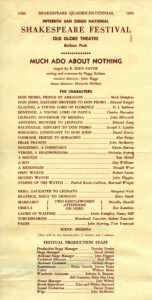
I was enchanted. I had been to only amateur theater the past two years, and this professional production was something to see on the Balboa Park stage. I could almost feel myself in the very first Globe Theatre in London, as The Bard Himself trod the boards.
Alan was a bit too whimsical as a student to take himself and the theater very seriously. In this play he had to be a minor villain helping with a foul deed, and he did it well. I concluded that I had seen him in bud form and now he was blossoming beautifully. He didn't have any publicity photos of himself in costume, so he slipped me this one as we sat in the Falstaff Tavern next door to the theater. He didn't autograph it, and I didn't ask him to. After all, I'm not a fan, just a proud friend.
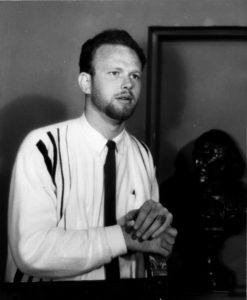
I came away convinced that Alan is indeed headed for Broadway and even the movies or TV when not on the Shakespearean stage. Look for him! And if you find yourself in San Diego for any reason, I strongly urge that you not miss out on your chance to time travel, in the Elizabethan manner…at the Old Globe.
[Come join us at Portal 55, Galactic Journey's real-time lounge! Talk about your favorite SFF, chat with the Traveler and co., relax, sit a spell…]

![[July 24, 1964] Much Ado About Something (Time Travel, San Diego-style)](https://galacticjourney.org/wp-content/uploads/2019/07/pc-000-367-672x372.jpeg)
















